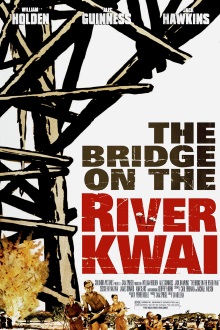
This is another of those films that are so famous as to be a household name. I remember that I did see it as a kid on television but was far too young to understand it. Watching it properly was long overdue and everything in it is new to me so I don’t remember anything at all except for the iconic marching tune. As with all such famous films, you tend to build up a mental picture of it even if you haven’t seen it due to cultural osmosis and I have to confess that I was shocked as this is nothing at all like what I thought it would be.
A battalion of British POWs led by Lieutenant Colonel Nicholson arrive at a Japanese-run camp and are ordered by the commandant Colonel Saito to build a bridge across the river Kwai in Burma. Saito insists that all of them do the work but Nicholson cites the Geneva Convention to shield the officers from hard labor and persists despite punishment. One of the last survivors of the previous batch of prisoners, the American Commander Shears observes all this for a while and then makes his escape. After a contest of wills between Nicholson and Saito that lasts for a month, Saito finally gives in and agrees that the officers do only administrative tasks. Reasoning that he needs to give his men something concrete to do to maintain their discipline, Nicholson resolves to build the bridge better than the Japanese could themselves. Meanwhile after making his way to Sri Lanka, Shears is recruited by a British commando unit to return to the camp to destroy the bridge.
Given what I knew about the film and its historical context, I expected this to be a record of the horrific conditions of life in the camp as they died like flies to finish the bridge and the railroad. I also expected the soldiers to do their best to sabotage the construction of the bridge while trying to stay alive. While this film does open with a grim shot of graves beside a railroad track, this is pretty much as bad as things get in this film. Saito does imprison Nicholson and the other British prisoners in shacks that must be a living hell to be in under the sun but we never see anyone dying of exhaustion, hunger or illness. In fact, the prisoners seem to be decently fed and are portrayed to be in rather good spirits once Nicholson starts cooperating with Saito to build the bridge in earnest. It’s completely ahistorical and extremely disconcerting to those who know how horrible things truly were to see how lightly it is treated here. The film includes shots of the military base where Shears recuperates and it essentially looks like a holiday resort with a beach and fantastic hillside scenery which doesn’t exactly set the right tone.
Stranger still is Nicholson’s attitude. At first, his resistance to Saito feels like it could be a heroic contest of moral principles. But it soon becomes clear that he is a stickler for military rules and pride to an insane extent. By the end of the film, he is much more the villain of the piece than Saito as he starts seeing the bridge as an enduring personal legacy. It’s astonishing to watch the film take such a turn and it instantly marks it out as being different from all other war films of the era. It makes more sense when I learned that it was adapted from a French novel which seems to me to have been explicitly critical against the British. Indeed Alec Guinness who played Nicholson complained to director David Lean about the anti-British nature of the film. I thought that perhaps Lean himself might have injected a measure of anti-war or anti-military sentiment in it himself. The sane man of the film, Shears, certainly is disgusted that he is conscripted against his will to participate in the raid and never stops saying that he only wants to return home.
In terms of production value, it’s visually rather obvious that this was not shot in Thailand or Myanmar at all. I also found it strange how few Japanese soldiers are around, which makes it hard to believe that they could keep order in a camp containing so many POWs. Scenes of the commando team flirting with pretty native girls feel cringey and completely out of place today. The whole thing does a horrible disservice to history and the real people who had to build the Burma Railway. Yet it is mesmerizing as a kind of twisted psychological portrait about Nicholson, I can’t say that I like it much but it is one of the most surprising films I’ve watched and makes for a subject of discussion.